System 10.1+ Synthesizer
[No Longer In Production]
Expandable, Fully Patchable, Semi-Modular Modular Synthesizer
The Pittsburgh Modular System 10.1+ Synthesizer is an expandable version of the System 10.1. Housed in our larger Cell[90] desktop case, the System 10.1+ has room to grow. The additional space allows a nearly infinite number of expansion options. The included black plastic blank panel can be easily trimmed as new modules are added to keep the case looking clean.
Just like the System 10.1, the System 10.1+ offers direct access to a wide array of modern, analog monosynth sounds. Without a single patch cable, floor shaking bass and aggressive leads are just a few knob tweaks away. Plugging in a few patch cables opens the Pittsburgh Modular System 10.1+ Synthesizer to complex experimentation by offering unlimited control over both the modulation and audio signal paths. All of the elements of a classic voltage controlled, analog modular synth are available as an open, patchable, modern synthesizer.
Features
The System 10.1+ Synthesizer features a complex waveforms oscillator. Standard triangle, square, and saw waves are available alongside a sub oscillator and our new blade wave. The blade wave is a rich, modulatable saw that can be controlled in several unique ways.
The System 10.1+ Synthesizer also features our new Lopass Gate. The Lopass Gate uses a highly tuned set of vactrols to produce everything from natural sounding filter sweeps and res’d out piercing leads to organic percussion. The Lopass Gate has 3 modes of operation: Low pass filter, VCA, and lopass gate. In lopass gate mode, the filter combines the features of both the low pass filter and VCA to produce a harmonically rich, intricate sound.
System 10.1+ Synthesizer Components
Synthesizer Box
(Complete, Fully Patchable, 2nd Generation Semi-Modular Synthesizer Voice)
Wired for instant access to classic tones without needing a single patch cable, the Synthesizer Box is a modern, complete semi-modular, monophonic synthesizer module. The Synthesizer Box is 100% analog and 100% Eurorack compatible with a complete set of patch points able to override the internal audio and CV signal paths.
The Synthesizer Box was designed to be the core of any modular system. Each major component is fully patchable and can function independent to the rest of the module. This allows the functionality of the Waveforms Oscillator, Lopass Gate, LFO, Envelope Generator, and VCA to be split apart and used like standalone modules.
Full Range, Complex Waveform Oscillator
Oscillator Waveform Mixer
Voltage Controlled Multi-Mode Lowpass Gate
Wide Range Low Frequency Oscillator
Glide Control for Portamento Effects
ADSR Envelope Generator
High Quality, Linear Response, Voltage Controlled Amplifier
Synthesizer Box Module Components

Waveforms
(Complex Waveform Oscillator)
The Waveforms oscillator is the heart of the Synthesizer Box. Complex modulation, voltage controlled waveform morphing, and a sub oscillator allow for a deep tones and rich timbres.
Waveforms Controls:
Coarse and Fine Tune Frequency Controls
Sub Oscillator - Square wave pitched one octave below the core oscillator creates a huge bottom end for the Synthesizer Box. Switch adjusts between low volume / off / full volume
Frequency Modulation (FM) - Used to modulate the pitch of the oscillator, The attenuated FM input can be switched between exponential and linear response. The FM input is internally patched to the LFO triangle output. This routing can be bypassed by patching into the FM CV IN input jack.
Saw / Blade Switch - Selects the type of saw wave sent to the mixer. The SAW wave is the core wave of the oscillator and is not effected by the MOD CV input. The BLADE wave is a unique, complex saw wave that can be modulated using the MOD CV input. Additional manipulation of the blade wave can be achieved using the BLADE IN jack.
Waveform Modulation (MOD CV) - Attenuated MOD CV input controls the amount of waveform modulation. Waveform modulation effects the square wave and blade wave. The modulation effects each wave type differently. Pulse width modulation of the square wave and wave shape morphing of the blade wave. The MOD CV input is internally patched to the LFO triangle output. This routing can be bypassed by patching into the MOD CV IN input jack.
Oscillator Patch Points:
1V/O IN - One volt per octave input.
BLADE IN - Blade wave manipulation input.
FM CV IN - Frequency modulation input overrides internal routing to allow for external modulation.
MOD CV IN - Waveform modulation input overrides internal routing to allow for external modulation.
TRI OUT - Post mixer triangle wave output.
S/B OUT - Post mixer saw or blade wave output.
SQR OUT - Post mixer square wave output.
MIX OUT - Mixer output includes triangle, saw/blade, square, and sub oscillator waveforms.

LPG
(Voltage Controlled Lopass Gate)
The LPG is a distinctive module that incorporates both a low pass filter and VCA. The lopass gate is unique in the way that it simulates the characteristics of natural instruments. When used in LPG mode, additional harmonic content is added to louder sounds while quieter sounds pass through unmodified. This behavior imparts a rich, organic quality on the sounds.
LPG Controls:
Frequency Modulation (MOD CV) - Attenuated MOD CV input controls the amount of lopass gate frequency modulation.
Mod / Ping Switch - Determines how the lopass gate responds to frequency modulation. In MOD mode, the MOD CV is used to sweep the frequency range of the lopass gate. In PING mode, the MOD CV is converted to a short trigger used to ping or strike the lopass gate. The PING mode takes advantage of the lopass gates fast attack and slow decay to create organic percussive sounds with a natural decay. The MOD CV input is internally patched to the envelope generator output. This routing can be bypassed by patching into the LPG CV IN input jack.
Frequency Control - In filter mode, the frequency knob controls the center frequency of the filter. In VCA mode, the frequency knob controls the pass through signal level. In lopass gate mode, the frequency knob controls both the center frequency of the filter and the pass through signal level.
Resonance Control - In filter mode, the resonance knob controls the amount of resonance. In VCA mode and lopass gate mode, the resonance knob is not active.
LPG Mode Switch - Switch between the 3 modes of the lopass gate. VCA position (up) enables VCA mode, LPG position (center) enables lopass gate mode, and LOPASS position (down) enables low pass filter mode.
LPG Patch Points:
LPG CV IN - Frequency modulation input overrides internal routing to allow for external modulation.
LPG IN - Signal input overrides internal routing.
LFP OUT - Signal output.
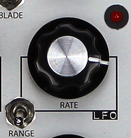
LFO
(Low Frequency Oscillator)
Wide Range LFO is perfect for long sweeps or audio rate frequency modulation.
LFO Controls:
Rate Knob - Selects the frequency of the low frequency oscillator.
Range Switch - Determines the range of the rate knob. Switches between low range and high range.
LFO Patch Points:
TRI OUT - Triangle wave output.
SQR OUT - Square wave output.
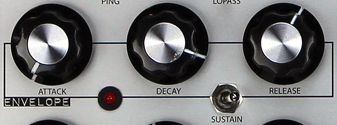
Envelope
(ADSR)
Four stage envelope generator.
Envelope Controls:
Attack Knob - The first stage of the envelope generator. The attack knob adjusts the rise time of the envelope.
Decay Knob - The second stage of the envelope generator. The decay knob adjusts amount of time the envelope remains at the maximum level while the envelope input contains a signal.
Sustain Switch - The third stage of the envelope generator. The sustain knob sets the maximum output level of the envelope once the decay stage has completed.
Release Knob - The fourth stage of the envelope generator. The release knob adjusts the amount of time it takes for the envelope to turn off once the decay stage has completed.
Envelope Patch Points:
ENV IN - Envelope input.
ENV OUT - Envelope output.
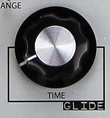
Glide
(Portamento)
Hardwired between the 1 Volt Per Octave Input (1V/O IN) and the waveforms oscillator.
Glide Controls:
Time Knob - Adjusts the amount of time it takes to shift from one frequency to another.
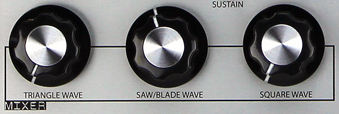
Mixer
(Waveforms Output Mixer)
Waveform mixer for oscillator outputs.
Mixer Controls:
Triangle Wave Attenuator - Adjust the level of the triangle wave sent to the TRI OUT and MIX OUT.
Saw / Blade Wave Attenuator - Adjust the level of the saw / blade wave sent to the S/B OUT and MIX OUT.
Square Wave Attenuator - Adjust the level of the square wave sent to the SQR OUT and MIX OUT.
Mixer Patch Points:
MIX OUT (in waveforms section) - Mixer output includes triangle, saw/blade, square, and sub oscillator waveforms.
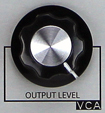
VCA
(Voltage Controlled Amplifier)
High quality, linear voltage controlled amplifier.
VCA Controls:
CV Input Attenuator Knob - Adjusts the output level of the VCA.
VCA Patch Points:
VCA CV IN - CV input. The VCA CV IN input is internally patched to the ENV OUT output. This routing can be bypassed by patching into the VCA CV IN input jack.
VCA IN - VCA signal input The VCA IN input is internally patched to the LPG OUT output. This routing can be bypassed by patching into the VCA IN input jack.
VCA OUT - Signal output.
MixMult
(Multifunction Utility Module)
3 Channel Mixer
2 Passive Multiples
The Mix Mult is a multifunction utility module. The module combines three important functions into a single module. A high quality three channel mixer and/or attenuator and two sets of passive multiples.
The mixer/attenuator section functions as a flexible, low-noise three channel mixer and/or attenuator for audio and cv that can be used in several ways. Patching into the output of channel 1 or 2 will remove that channel from the mixer circuit and turn the channel into an independent passive signal attenuator. Channel 3 can not be removed from the mixer circuit, however if channel 1 and 2 are all being used as attenuators, channel 3 is the only input remaining in the mixer allowing it to be used as a buffered attenuator. The mixer knobs are wired with a logarithmic volume curve that is tuned for use with audio but it will work with CV as well.
The bottom of the module contains two sets of passive multiples. Patching a signal into one of the multiple jacks will split the signal to the remaining two jacks. allowing a single audio or CV signal to be used in two places at once.
Midi 3
(Extremely Full Featured MIDI to CV Converter)
The Midi 3 converts standard midi note messages into the analog control voltages used by modular synthesizers. This allows a modular synthesizer to be controlled by a midi keyboard, sequencer, or DAW.
The two sets of Gate (GT) outputs can be used to trigger envelope generators by providing a voltage of +5v. The Control Voltage (CV) outputs produce precisely 1volt per octave over a range of 10 octaves. Pitch bend, assignable CC and dedicated velocity outputs, a feature rich clock source with tap tempo, midi and external gate clock dividers, and multiple arpeggiator responses. This module is deep.
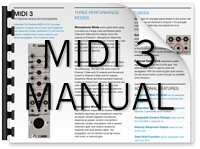
Outs
(Audio Output Module)
The simplest way to get sound out of a modular. Outs is a dual independent output module featuring a stereo 1/4" headphone amplifier output and dual mono 1/4" line level outputs.
Left and Right inputs are available. If only the left input is used, the signal is sent to both the Left and Right outputs.
System 10.1+ Synthesizer Manual
System 10.1+ Synthesizer Specs
Pittsburgh Modular Cell[90] DC Desktop Case
90hp Eurorack Desktop Case, with single row wood sides
Dimensions: 19.5" x 5.5" x 2.5"
The included Pittsburgh Modular DC power supply provides +12V @ 900mA, -12v @ 700mA, +5V @ 500mA of power. A custom flexible power rail delivers a full compliment of power and the eurorack bus system to the modules using standard 16 pin keyed power headers. The power board uses an external 15V DC 2.6A DC power adapter.
6x Patch Cables











